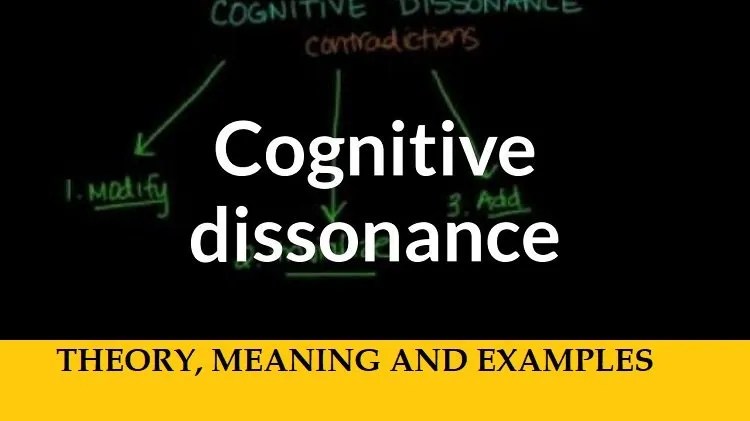
There are times when the behavior of certain individuals does not correspond with their thought processes. For example, consider a couple who care for each other yet say nasty things to themselves to be right in an argument or manipulate the other into doing something in their own self-interest. After a while, they feel horrible about their actions and tell themselves, “They started it after all.” Or a person who strives to avoid consuming junk food to improve their health, then they hang out with their buddies and there’s a large slice of pizza on the table, ready for someone to take a piece. At the moment, let’s say Pizza is their favorite junk food, so they rush in and eat it all. After a while, they begin to feel guilty, but they console themselves by remembering that it is just a slice. In these two situations, you can ask whether the people involved are in love with their spouses or if they are concerned about improving their health. While in actual sense, they are concerned about them, and they do want to live a healthy lifestyle. Their actions, on the other hand, are the direct opposite of what they think. These examples of cognitive dissonance are good illustrations of the phenomenon.
Meaning of Cognitive Dissonance
Cognitive dissonance is a form of mental conflict or discomfort that a person suffers when their actions, way of life, behaviors, or habits are in opposition to what they believe or stand for. Simply put, cognitive dissonance is a psychological phenomenon that emerges when a person’s beliefs and actions do not agree with one another.
Examples of Cognitive Dissonance
Very often, the examples of cognitive dissonance that are mentioned are instances in which we defend or justify our actions or indiscretions. However, there are situations when cognitive dissonance may assist us in establishing desirable practices or adjustments that our dispositions or prior habits would otherwise prevent us from doing. Like the pizza-loving guy we previously covered, cognitive dissonance was the driving force behind his decision to pursue a better lifestyle.
Sometimes, it happens to those who we do expect to violate some rules due to the standards they have set for themselves. Here we have Margaret, who is a sophisticated lady. Below is a description of her share of cognitive dissonance:
Margaret is a well-organized woman whose home is enveloped with the fragrance of roses and peaches. She is tidy and never leaves flits lying around her house. You’ll seldom find dishes in the sink or soiled clothes strewn about her flat. Margaret became so busy that she had little time for housework. She was getting ready to leave for work one day, when she realized she didn’t have any nice and neat clothes to wear. She took a glance at her pile of unwashed clothing and decided to hunt for a less filthy top. She quickly selects one, dresses up in it, sprays some good perfumes, and heads for work. On her way to work, she begins to feel awful about wearing a soiled top and is worried that she might stink if she sweats too much. Then she consoles herself with the knowledge that this is just a one-off situation and not something that she is accustomed to and that, this minor setback would only be for that particular day.
Margaret would probably not do that again, but we can see how she made herself feel better by reminding herself that she wasn’t an unkempt person.
Some individuals tend to think that cognitive dissonance is a form of mental disability. Cognitive dissonance is not a mental health illness; it is a mental discomfort. It can occur to any individual. This means that it is not bound to happen to a selected group of people.
A Theory of Cognitive Dissonance
Cognitive dissonance was postulated for the first time in 1957, by an American psychologist named Leon Festinger. Leon’s results were based on empirical research of a cult that believed the world was soon to be destroyed by a flood, which he conducted himself. His members, notably the most dedicated ones who had given up their homes and careers to serve the cult when the deluge did not happen, were his case studies.
The results showed that although the cult members were more willing to admit that they had made a fool of themselves and recorded it as an experience, some were defensive. Committed members were more likely to re-interpret the facts to demonstrate that they had been correct all along. Instead, they were comforted by believing that the cult’s members’ devotion had prevented the earth from being submerged in a flood.
The cognitive dissonance hypothesis, developed by Festinger, proposes that humans have an internal impulse to keep all of their attitudes and actions in harmony and avoid discord at all costs. Humans are continuously looking for strategies to ensure that their ideas and behaviors are in sync and do not conflict. They don’t want to be seen as hypocrites, so they often examine themselves. The concept of cognitive consistency is the term used to describe this.
When there is a misalignment between attitudes and actions, something has to change to alleviate the dissonance between the two.
In conformity with the cognitive dissonance theory, when an individual’s actions contradict their views and beliefs, underlying psychological stress is developed. Following this underlying stress, a person is compelled to adopt a new attitude that results in more consistency between thoughts and actions. Several studies have shown that when a person participates in activities that are contradictory to their attitudes and beliefs, an attitude shift that is compatible with the direction of their conduct occurs. This technique of thinking or attitude transformation, is the same mechanism that is employed to bring about changes in negative, illogical ideas that are implicated in the maintenance of depression and other associated disorders.
Cognitive dissonance comes in four different theoretical paradigms or patterns. They are:
- Paradigm of Belief Disconfirmation
- Induced Compliance Paradigm
- Paradigm of Free Choice
- Effort Justification Paradigm.
Below, these paradigms will be discussed one by one for better understanding. They go as follows:
- Paradigm of Belief Disconfirmation
Belief Disconfirmation is a psychological phrase that points to what is often referred to as a failed prophesy in the real world. The concept of this is that when an individual is confronted with new information that contradicts their view, they will instead rationalize their old opinion into a new belief. This new belief integrates both the old and the recent data. Instead of acknowledging that their previous faith was incorrect in the first place, they justify it with some soothing affirmations. This may be avoided by agreeing ahead of time on what evidence would persuade you that your ideas are incorrect. This essentially removes the emotional cost of being incorrect, which is what pushes individuals to rationalize and substitutes it with the emotional reward of publicly upholding their promise. Belief disconfirmation usually leaves an individual to make a choice. The choices there are: the person must either abandon the now-discredited idea or provide a rationale for why it was not discredited in the first place. We can see belief disconfirmation play out amongst the cult members who, instead of acknowledging that the prophesy was false, decided to believe that their faith stopped the flood from happening. In other words, belief disconfirmation is when an individual convinces themselves that what they previously believed was true, by claiming it resulted from the new data.
Induced Compliance Paradigm
Forced compliance is another word that is used to refer to induced compliance. Cognitive dissonance is intended to be induced via this challenging task. We may infer from the phrase “induced compliance” that changing an individual’s belief would be coerced. According to this hypothesis, someone in a position of power or another perceived higher entity may push a lower-ranking person to make statements or engage in activities that run counter to their moral ethics. Its goal is to alter an individual’s state of mind via the use of persuasion and power. Consider the case of a morally sound person. Then they are compelled to change a test or examination result by their superiors at work or they will be dismissed. This individual may have no option but to cooperate or risk losing their employment. They would feel awful about this conduct since it is not in accordance with their beliefs. This person may opt to leave their employment owing to the guilt associated with their activities, yet they may defend their behaviors by stating that they do not occur on a regular basis.
We also see an example of induced compliance in Festinger’s experiment, which he carried out in the late 1950s. The experiment involved male students. The participants were forced to do a difficult exercise that they didn’t find interesting. The experimental condition involves informing the individual ahead of time that the experiment would be enjoyable. However, the organizers did not create any fun activities. The students were invited into a room where they would be questioned about their experience. After the interview, the students were given either $1 or $20. They were to give this money to the next participant to persuade them that the experiment was enjoyable. The reason for the study was to see which of the participants would testify to the next participants that they enjoyed the experiment. However, the group who were given one dollar each were able to persuade the next group that the study was enjoyable. Whereas, the students who belonged to the $20 group did not persuade the next group that it was a fun activity. According to the findings, when a person is motivated by a reward to say something opposed to their private view, their private belief tends to alter as a consequence. When the incentive was lower, the degree of the dissonance was greater, and as a result, the urge to minimize the dissonance was greater.
Paradigm of Free Choice
We may deduce from the word “free choice” that it refers to the freedom to make a choice. We could wonder how decision freedom relates to cognitive dissonance. When individuals are given two or more options, they are at liberty to make a decision. To make this decision, individuals must be persuaded that the option they are considering is the best one for them. To persuade themselves and lessen inconsistency and the sense of dissonance, the chooser might alter their preferences such that they desire the selected item more and the rejected object less than before the choice. This altercation helps the individual cope with the fact that they did not pick the other options, which might be better. It is usually considered that it occurs because making a choice causes cognitive dissonance. The guilt that comes later is subsequently alleviated through rationalizing.
Effort Justification Paradigms
An effort justification theory holds that, when individuals make sacrifices to achieve a goal, the effort is typically justified by enhancing the desirability of the objective. When a person expends a lot of effort to complete a project and does not get the anticipated outcome, they change the quality of the outcome to equate it with the energy expended.
The justification of effort makes the objects look more valuable and justifies the effort used in reaching the goal. This seems to be more helpful than feeling as though all of your efforts went to nothing. Let’s have a look at an example in the late 1950s: Elliott Aronson and Judson Mills conducted a well-known investigation involving women. In those times, women were often protected and expected to be morally intact. Aronson and Mills informed female participants that they were being considered for membership in a discussion group on the psychology of sexuality. However, before they could join, they were asked to read aloud a list of terms connected to sexuality in order to ensure that they would not be too humiliated to participate in the debate after they were admitted into the group. The first sets of women were instructed to read phrases about sexuality that were not obscene. The second group was instructed to read aloud profane language. They were also made to read two explicit accounts of sex activities from period books. Clearly, the second group had to put in a lot more effort to be allowed into the discussion group.
After that, the individuals were subjected to a tape of a conversation about animal sexuality that was both boring and uninspiring. Finally, the group and its members were rated by the participants. Those who had to read the more explicit and vulgar sentences beforehand consistently rated the group higher than those who did not.
This experiment demonstrated that even if a person’s output into a project was worth more than the product delivered, the individual engaged would appreciate the outcome. This is done to persuade oneself that their efforts were not in vain.
Based on everything we’ve studied so far, we may infer that the cognitive dissonance theory opines that when an individual’s actions contradict his or her opinions and beliefs, an underlying psychological tension is formed. This underlying tension then motivates an individual to adopt a new attitude, resulting in consistency between thoughts and actions.

![Rothamsted International – University of Nottingham (RI-UON) Fellowship 2019 [Fully Funded]](https://schoolgist.ng/storage/postFiles/schoolgist-default-post-image.webp)

